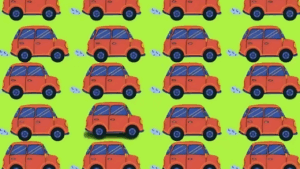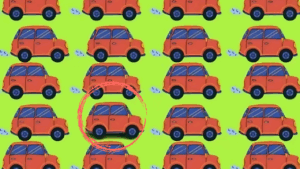Optical illusions have long fascinated people by challenging their perception and cognitive abilities, and the latest viral sensation, “Find the Odd Car in 8 Seconds,” is no exception. This brain teaser, sweeping across social media and puzzle websites, presents a grid of seemingly identical cars, with one vehicle hiding a subtle difference. With only 8 seconds to find the odd one out, this illusion tests your visual acuity, focus, and quick thinking. In this article, we explore the mechanics of this optical illusion, why it’s so difficult, its cognitive benefits, strategies to solve it, and how it compares to other popular puzzles, all while diving into the science and appeal of optical illusions.
The Odd Car Optical Illusion: What’s the Challenge?
The “Find the Odd Car in 8 Seconds” challenge features a grid of cars, typically arranged in a 6×5 or 5×5 pattern, totaling 25–30 vehicles. Each car appears identical at first glance, often depicted in a uniform color like red, blue, or green, with similar shapes and features, such as headlights, wheels, and side mirrors. However, one car stands out due to a subtle anomaly—perhaps a missing side mirror, a different wheel design, a slightly altered color shade, or a unique bumper shape. The task is to identify this odd car within the tight 8-second time limit, making it a thrilling test of observation and mental agility.

This illusion, popularized by outlets like Times Now and Jagran Josh, leverages the brain’s tendency to group similar objects, a process known as perceptual grouping. The uniformity of the cars creates a visual overload, making it hard to spot the anomaly quickly. The time constraint adds pressure, forcing participants to balance speed and accuracy, which amplifies the challenge and excitement.
Why Optical Illusions Are So Tricky
Optical illusions exploit the quirks of human perception. Our brains are wired to process visual information efficiently by recognizing patterns and ignoring minor differences, a survival mechanism that helps us navigate complex environments. In the odd car illusion, the repetitive design of the cars tricks the brain into assuming uniformity, a phenomenon called “change blindness.” This makes spotting the odd car difficult, as the brain glosses over subtle discrepancies.
The illusion engages multiple brain regions, including the visual cortex, which processes raw visual data, and the prefrontal cortex, responsible for attention and decision-making. The 8-second time limit increases cognitive load, as the brain must rapidly scan, compare, and identify differences under pressure. According to research, such tasks challenge visual processing and working memory, making optical illusions like this both mentally stimulating and frustrating.
Cognitive Benefits of Optical Illusions
Solving optical illusions like the odd car challenge offers more than just a fun distraction. These puzzles provide several cognitive benefits, supported by studies on brain teasers and visual perception:
-
Enhanced Observation Skills: Regularly engaging with illusions sharpens your ability to notice fine details, improving skills like proofreading or detecting errors in complex datasets.
-
Improved Focus and Concentration: The time pressure trains your brain to block distractions, enhancing sustained attention, which is valuable in multitasking environments.
-
Boosted Problem-Solving: Optical illusions require creative thinking and pattern recognition, fostering analytical skills that translate to real-world problem-solving.
-
Mental Agility: Quickly switching perspectives to spot anomalies enhances cognitive flexibility, helping you adapt to new challenges.
-
Stress Relief: Solving puzzles can be meditative, offering a mental break from daily stressors and promoting relaxation.
Those who spot the odd car within 8 seconds demonstrate superior visual processing and high cognitive acuity, often associated with strong IQ and attention to detail. Even if you don’t succeed, the act of trying strengthens neural pathways, making future puzzles easier to solve.
Strategies to Spot the Odd Car
Finding the odd car in 8 seconds requires a strategic approach. Here are some expert tips to improve your success rate:
-
Systematic Scanning: Divide the grid into smaller sections, such as rows or quadrants, and scan each methodically to avoid visual overload.
-
Focus on Key Features: Pay attention to specific car elements, like side mirrors, wheels, or headlights. The anomaly is often a subtle change, such as a missing mirror or different wheel size.
-
Use Peripheral Vision: Instead of fixating on one car, let your eyes sweep broadly across the grid to catch differences that pop out in your peripheral field.
-
Look for Color Variations: Even slight shade differences, like a darker red or muted blue, can indicate the odd car.
-
Practice Under Pressure: Train with similar puzzles to improve your speed and accuracy, as regular practice enhances pattern recognition.
If you’re struggling, a common hint from sources like Times Now suggests focusing on the third row or the right side of the grid, where the odd car might have a feature like a missing indicator or a unique tire color.
Comparison with Other Optical Illusions
The odd car illusion is part of a family of “spot the difference” puzzles that test visual discrimination. Below is a table comparing it to other popular optical illusions, highlighting their unique challenges:
|
Puzzle |
Description |
Time Limit |
Key Skill Tested |
Difficulty |
|---|---|---|---|---|
|
Odd Car Challenge |
Find one car with a subtle difference (e.g., missing mirror) in a grid of cars. |
8 seconds |
Visual discrimination |
Moderate |
|
Hidden Number (e.g., 94 among 49s) |
Spot a number like 94 in a grid of 49s. |
5 seconds |
Pattern recognition |
Hard |
|
Hidden Animal (e.g., Snow Leopard) |
Find a camouflaged animal in a natural scene, like a leopard in rocks. |
8 seconds |
Attention to detail |
Hard |
|
Red Card Illusion |
Identify one different red card in a grid of 30 cards. |
10 seconds |
Visual acuity |
Moderate |
|
Chess Piece Illusion |
Find one unique chess piece among similar pieces. |
5 seconds |
Rapid decision-making |
Very Hard |
Each puzzle targets different aspects of perception, but the odd car challenge stands out for its fast-paced nature and automotive theme, appealing to car enthusiasts and puzzle lovers alike.
The Science Behind Optical Illusions
Optical illusions reveal fascinating insights into how the brain processes visual information. There are three main types of illusions, as outlined by Jagran Josh:
-
Literal Illusions: Misinterpretations of an object’s physical properties, like mistaking a car’s shadow for a floating vehicle.
-
Physiological Illusions: Caused by how eyes and brains process light and color, such as afterimages where staring at one color creates a complementary color effect.
-
Cognitive Illusions: Result from the brain’s assumptions about patterns, like assuming all cars in a grid are identical, leading to change blindness.
The odd car illusion is primarily a cognitive illusion, as the brain assumes uniformity across the grid, making the anomaly hard to spot. This is compounded by physiological factors, as the eyes struggle to differentiate subtle color or shape variations under time pressure. Scientists use such illusions to study visual processing and neural adaptation, offering insights into perception and cognition.
Why This Illusion Went Viral
The odd car challenge has captured the internet’s attention due to its accessibility and competitive edge. Shared across platforms like Times of India and Hindustan Times, it encourages users to test their skills and share their times, fostering online engagement. The automotive theme resonates with car enthusiasts, while the 8-second time limit adds a thrilling urgency. Social media amplifies its appeal, as users post their successes or debate the solution, creating a sense of community. The puzzle’s simplicity—no special tools required—makes it universally accessible, while its difficulty ensures a satisfying “aha!” moment when solved.

The Future of Optical Illusions
As digital platforms evolve, optical illusions are becoming more interactive and complex. From 3D billboards to augmented reality puzzles, technology is enhancing the way we experience visual challenges. The odd car illusion, with its straightforward yet deceptive design, represents a classic format that remains timeless. Future iterations might incorporate dynamic elements, like moving cars or changing colors, to increase difficulty. For now, this puzzle continues to captivate, proving that even simple images can stump the sharpest minds.
Looking Ahead
The “Find the Odd Car in 8 Seconds” optical illusion is a delightful blend of fun and mental exercise, challenging your observation skills and quick thinking. Its viral popularity underscores the universal appeal of brain teasers, which entertain while sharpening cognitive abilities. By understanding the science behind illusions, applying strategic scanning techniques, and practicing regularly, you can master this puzzle and others like it. Whether you spot the odd car in 8 seconds or need a few extra moments, the thrill of discovery and the cognitive benefits make it a worthwhile challenge. So, set your timer, scan the grid, and see if you can claim the title of a true visual master!
